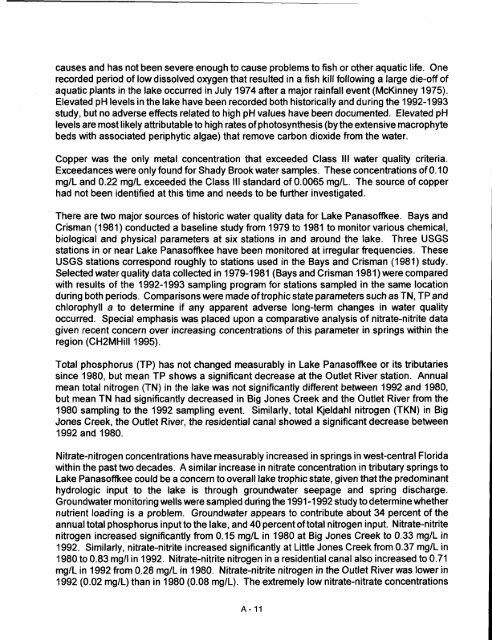Lake Panasoffkee SWIM Plan - Southwest Florida Water ...
Lake Panasoffkee SWIM Plan - Southwest Florida Water ...
Lake Panasoffkee SWIM Plan - Southwest Florida Water ...
Create successful ePaper yourself
Turn your PDF publications into a flip-book with our unique Google optimized e-Paper software.
causes and has not been severe enough to cause problems to fish or other aquatic life. One<br />
recorded period of low dissolved oxygen that resulted in a fish kill following a large die-off of<br />
aquatic plants in the lake occurred in July 1974 after a major rainfall event (McKinney 1975).<br />
Elevated pH levels in the lake have been recorded both historically and during the 1992-1993<br />
study, but no adverse effects related to high pH values have been documented. Elevated pH<br />
levels are most likely attributable to high rates of photosynthesis (by the extensive macrophyte<br />
beds with associated periphytic algae) that remove carbon dioxide from the water.<br />
Copper was the only metal concentration that exceeded Class 111 water quality criteria.<br />
Exceedances were only found for Shady Brook water samples. These concentrations of 0.10<br />
mg/L and 0.22 mg/L exceeded the Class 111 standard of 0.0065 mg/L. The source of copper<br />
had not been identified at this time and needs to be further investigated.<br />
There are two major sources of historic water quality data for <strong>Lake</strong> Panasornee. Bays and<br />
Crisman (1981) conducted a baseline study from 1979 to 1981 to monitor various chemical,<br />
biological and physical parameters at six stations in and around the lake. Three USGS<br />
stations in or near <strong>Lake</strong> <strong>Panasoffkee</strong> have been monitored at irregular frequencies. These<br />
USGS stations correspond roughly to stations used in the Bays and Crisman (1981) study.<br />
Selected water quality data collected in 1979-1 981 (Bays and Crisman 1981) were compared<br />
with results of the 1992-1993 sampling program for stations sampled in the same location<br />
during both periods. Comparisons were made of trophic state parameters such as TN, TP and<br />
chlorophyll a to determine if any apparent adverse long-term changes in water quality<br />
occurred. Special emphasis was placed upon a comparative anatysis of nitrate-nitrite data<br />
given recent concern over increasing concentrations of this parameter in springs within the<br />
region (CH2MHill 1995).<br />
Total phosphorus (TP) has not changed measurably in <strong>Lake</strong> <strong>Panasoffkee</strong> or its tributaries<br />
since 1980, but mean TP shows a significant decrease at the Outlet River station. Annual<br />
mean total nitrogen (TN) in the lake was not significantly different between 1992 and 1980,<br />
but mean TN had significantly decreased in Big Jones Creek and the Outlet River from the<br />
1980 sampling to the 1992 sampling event. Similarly, total Kjeldahl nitrogen (TKN) in Big<br />
Jones Creek, the Outlet River, the residential canal showed a significant decrease between<br />
1992 and 1980.<br />
Nitrate-nitrogen concentrations have measurably increased in springs in west-central <strong>Florida</strong><br />
within the past two decades. A similar increase in nitrate concentration in tributary springs to<br />
<strong>Lake</strong> Panasornee could be a concern to overall lake trophic state, given that the predominant<br />
hydrologic input to the lake is through groundwater seepage and spring discharge.<br />
Groundwater monitoring wells were sampled during the 1991-1 992 study to determine whether<br />
nutrient loading is a problem. Groundwater appears to contribute about 34 percent of the<br />
annual total phosphorus input to the lake, and 40 percent of total nitrogen input. Nitrate-nitrite<br />
nitrogen increased significantly from 0.15 mg/L in 1980 at Big Jones Creek to 0.33 mg/L in<br />
1992. Similarly, nitrate-nitrite increased significantly at Little Jones Creek from 0.37 mglL in<br />
1980 to 0.83 mgll in 1992. Nitrate-nitrite nitrogen in a residential canal also increased to 0.71<br />
mg/L in 1992 from 0.28 mg/L in 1980. Nitrate-nitrite nitrogen in the Outlet River was lower in<br />
1992 (0.02 mg/L) than in 1980 (0.08 mg/L). The extremely low nitrate-nitrate concentrations<br />
A- 11
















